
Ammonoids are extinct spiral shelled cephalopods comprising the subclass Ammonoidea. They are more closely related to living coleoids than they are to shelled nautiloids. The earliest ammonoids appeared during the Devonian, with the last species vanishing during or soon after the Cretaceous–Paleogene extinction event. They are often called ammonites, which is most frequently used for members of the order Ammonitida, the only living group of ammonoids from the Jurassic up until their extinction.

The nautilus is an ancient pelagic marine mollusc of the cephalopod family Nautilidae. The nautilus is the sole extant family of the superfamily Nautilaceae and the suborder Nautilina.

Spirula spirula is a species of deep-water squid-like cephalopod mollusk. It is the only extant member of the genus Spirula, the family Spirulidae, and the order Spirulida. Because of the shape of its internal shell, it is commonly known as the ram's horn squid or the little post horn squid. Because the live animal has a light-emitting organ, it is also sometimes known as the tail-light squid.

The vampire squid is a small cephalopod found throughout temperate and tropical oceans in extreme deep sea conditions. The vampire squid uses its bioluminescent organs and its unique oxygen metabolism to thrive in the parts of the ocean with the lowest concentrations of oxygen. It has two long retractile filaments, located between the first two pairs of arms on its dorsal side, which distinguish it from both octopuses and squids, and places it in its own order, Vampyromorphida, although its closest relatives are octopods. As a phylogenetic relict, it is the only known surviving member of its order.

The argonauts are a group of pelagic octopuses. They are also called paper nautili, referring to the paper-thin eggcase that females secrete; however, as octopuses, they are only very distant relatives of true nautili. Their structure lacks the gas-filled chambers present in chambered nautilus shells and is not a true cephalopod shell, but rather an evolutionary innovation unique to the genus. It is used as a brood chamber, and to trap surface air to maintain buoyancy. It was once speculated that argonauts did not manufacture their eggcases but utilized shells abandoned by other organisms, in the manner of hermit crabs. Experiments by pioneering marine biologist Jeanne Villepreux-Power in the early 19th century disproved this hypothesis, as Villepreux-Power successfully reared argonaut young and observed their shells' development.

Nautiloids are a group of marine cephalopods (Mollusca) which originated in the Late Cambrian and are represented today by the living Nautilus and Allonautilus. Fossil nautiloids are diverse and species rich, with over 2,500 recorded species. They flourished during the early Paleozoic era, when they constituted the main predatory animals. Early in their evolution, nautiloids developed an extraordinary diversity of shell shapes, including coiled morphologies and giant straight-shelled forms (orthocones). No orthoconic and only a handful of coiled species, the nautiluses, survive to the present day.
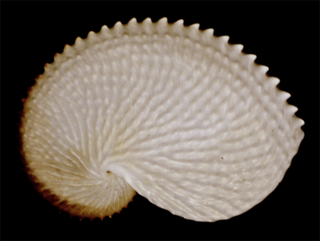
Argonauta nodosus [previously known as Argonauta nodosa], also known as the knobby or knobbed argonaut, is a species of pelagic octopus. The female of the species, like all argonauts, creates a paper-thin eggcase that coils around the octopus much like the way a nautilus lives in its shell. The shell is usually approximately 150 mm in length, although it can exceed 250 mm in exceptional specimens; the world record size is 292.0 mm. A. nodosus produces a very characteristic shell, which is covered in many small nodules on the ridges across the shell, hence the specific epithet nodosus and common name. These nodules are less obvious or even absent in juvenile females, especially those under 5 cm in length. All other argonaut species have smooth ridges across the shell walls.
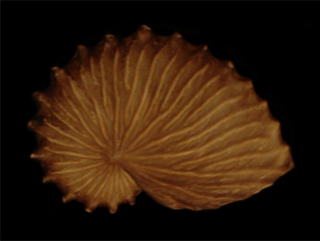
Argonauta bottgeri, also known as Böttger's argonaut, is a species of pelagic octopus belonging to the genus Argonauta. The female of the species, like all argonauts, creates a paper-thin eggcase that coils around the octopus much like the way a nautilus lives in its shell.
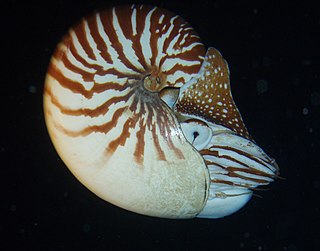
Nautilus macromphalus, the bellybutton nautilus, is a species of nautilus native to the waters off New Caledonia and northeastern Australia. The shell of this species lacks a callus, leaving the umbilicus exposed, in which the inner coils of the shell are visible. This opening constitutes about 15% of the shell diameter at its widest point.

The Palau nautilus is a nautiloid mainly found off of Palau in the Western Carolines. It can be found on fore reef slopes, at depths of 95m-504m (311'-1,653'), though typically preferring a range of 150m-300m (492'-984'), where water temperatures stay around 16.6 °C (61.88°F) and do not go much lower than 9.4 °C (48.92°F). N. belauensis are highly mobile, epibenthic scavengers and opportunistic predators which rely mostly on scent for finding food. They are active both diurnally and nocturnally within their preferred depth ranges, although most shallow-water incursions are, generally, nocturnal events that coincide with greatly diminished fish activities.

Nautilus is a marine cephalopod genus in the mollusk family Nautilidae. Species in this genus differ significantly, morphologically, from the two nautilus species in the adjacent sister-taxon Allonautilus. The oldest fossils of the genus are known from the Late Eocene Hoko River Formation, in Washington State and from Late-Eocene to Early Oligocene sediments in Kazakhstan. The oldest fossils of the modern species Nautilus pompilius are from Early Pleistocene sediments off the coast of Luzon in the Philippines.
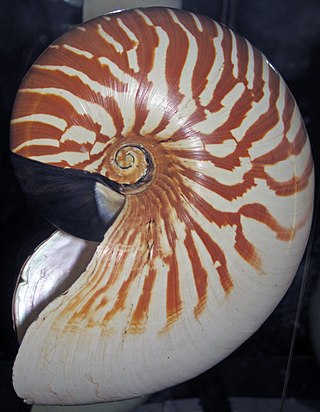
Nautilus stenomphalus, also known as the white-patch nautilus, is a species of nautilus native to the Great Barrier Reef. N. stenomphalus is very similar to N. pompilius and may in fact represent a subspecies. It is separated by the absence of a thickened callus and the presence of white patches in the umbilical and shoulder regions of the shell. The sheaths of this species have scalloped edges compared with the smooth sheaths of N. pompilius. N. stenomphalus also differs slightly in hood ornamentation. The shell is usually up to around 180 mm in diameter, although the largest specimen ever recorded measured 201 mm.

Allonautilus scrobiculatus, also known as the crusty nautilus or fuzzy nautilus, is a species of nautilus native to the waters around New Guinea, specifically New Britain and Milne Bay, and the Solomon Islands. A. scrobiculatus is recognizable by the large open umbilicus, which is around 20% of the shell diameter at its widest point. This species, along with the closely related A. perforatus, were originally placed in the genus Nautilus, but have recently been given their own genus on account of significant morphological differences. The most obvious are features of the shell, including crease and an encrusting layer (periostracum) that covers most of the shell. Gills and reproductive structures also differ significantly from members of the genus Nautilus. The shell is usually up to around 18 cm in diameter, although the largest specimen ever recorded measured 21.5 cm. The species was thought to have gone extinct after 1986, but was rediscovered in July 2015.
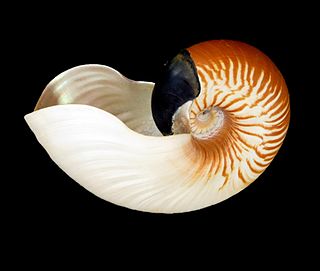
Allonautilus perforatus also known as the Bali chambered nautilus, is a species of nautilus native to the waters around Bali, Indonesia. It is known only from drifted shells and, as such, is the least studied of the six recognized nautilus species. Thus, not much is known about it outside of the shell.
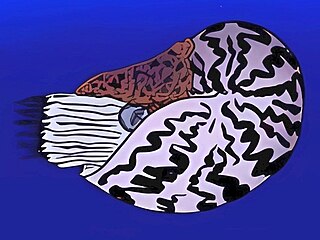
Nautilus cookanus is an extinct species of nautilus. It lived during the Eocene epoch. N. cookanus placed within the genus Nautilus, together with extant species based on their shared shell characters. Fossils of the species from the Late Eocene Hoko River Formation are noted as one of the two oldest occurrences for the genus. Its name has frequently been misspelled as "cookanum".

Nautilus praepompilius is an extinct species of nautilus. It lived from the Late Paleocene through Oligocene epochs. The first fossil specimens discovered in the Late Eocene to Oligocene-aged Chegan Formation of Kazakhstan: an additional, older specimen was found in the Late or Latest Paleocene-aged Pebble Point Formation in Victoria, Australia. N. praepompilius has been grouped into a single genus together with extant species based on their shared shell characters. It is morphologically closest to N. pompilius, hence the name. The nepionic constriction shows that the hatching size was approximately 23 mm, close to that for N. pompilius. N. praepompilius, along with aff. N. cookanum fossils from the late Eocene Hoko River Formation in Washington state are the oldest occurrences of the genus.
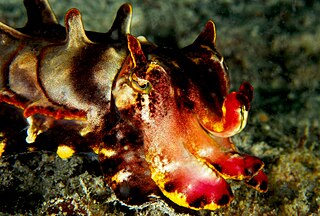
Metasepia pfefferi, also known as the flamboyant cuttlefish, is a species of cuttlefish occurring in tropical Indo-Pacific waters off northern Australia, southern New Guinea, as well as numerous islands of the Philippines, Indonesia and Malaysia.

All cephalopods possess flexible limbs extending from their heads and surrounding their beaks. These appendages, which function as muscular hydrostats, have been variously termed arms, legs or tentacles.
The cephalopods have a long geological history, with the first nautiloids found in late Cambrian strata, and purported stem-group representatives present in the earliest Cambrian lagerstätten.
Jerimalai is a limestone cave southeast of Tutuala, on the eastern tip of East Timor. Fish remains and fish hooks excavated in Jerimalai provide evidence for advanced fishing technique by inhabitants of Timor 42,000 years ago.


























